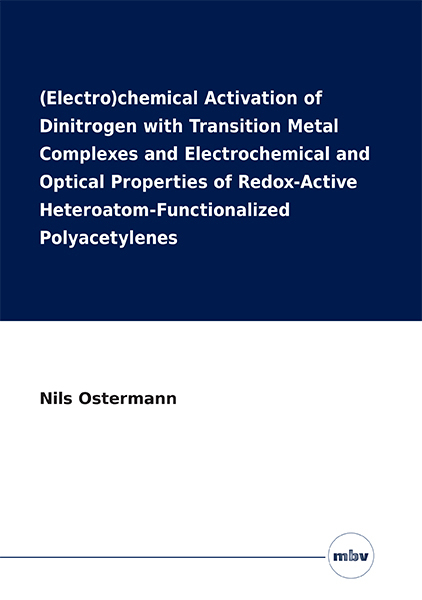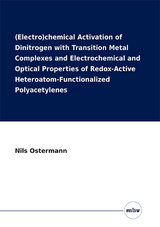(Electro)chemical Activation of Dinitrogen with Transition Metal Complexes and Electrochemical and Optical Properties of Redox-Active Heteroatom-Functionalized Polyacetylenes
Seiten
2023
|
1. Aufl.
Mensch & Buch (Verlag)
978-3-96729-223-7 (ISBN)
Mensch & Buch (Verlag)
978-3-96729-223-7 (ISBN)
Electron transfer reactions are key steps in chemical transformations. Commonly proceeded by the use of chemical oxidizing and reducing agents, the use of the electrochemistry offers a promising alternative. The simple tunability of the redox potential at the electrode and the production of less chemical waste outline the advantages of the electrochemistry over chemical redox agents. Furthermore, in the context of going to renewable energy resources, the use of green energy like sunlight or wind can be used as the energy input. Following this more sustainable approach of electrosynthesis, researchers developed growing interest in the field of molecular electrochemistry during the last decades.
The use of electrochemistry not only offers a greener alternative to common synthetic approaches, but also provides a powerful tool to understand electron transfer reactions. With the use of cyclic voltammetry (CV), exact redox potentials can be defined and thermodynamic and kinetic information of the electron transfer and follow up reactions as well as catalytic efficiencies can be investigated. However, electrochemistry does not provide insights about structural information of intermediates or products. Hence, spectroelectrochemical (SEC) techniques were developed to combine the advantages of electrochemistry with molecular spectroscopy to further understand reaction mechanisms. Upon potential control spectroscopic profiles can be in situ generated including spectra of vibrational frequencies, molar absorptivities, luminescence intensities and electronic or magnetic resonance frequencies.
The ability to understand chemical and electrochemical processes will be examined in this thesis for different molecular systems. Insights into electronic properties could be gained with the help of electrochemical measurements. In this context, cyclic voltammetry studies and controlled potential electrolysis (CPE) as well as combined spectroelectrochemical experiments, in particular UV/Vis/nIR/IR-SEC measurements were performed.
The use of electrochemistry not only offers a greener alternative to common synthetic approaches, but also provides a powerful tool to understand electron transfer reactions. With the use of cyclic voltammetry (CV), exact redox potentials can be defined and thermodynamic and kinetic information of the electron transfer and follow up reactions as well as catalytic efficiencies can be investigated. However, electrochemistry does not provide insights about structural information of intermediates or products. Hence, spectroelectrochemical (SEC) techniques were developed to combine the advantages of electrochemistry with molecular spectroscopy to further understand reaction mechanisms. Upon potential control spectroscopic profiles can be in situ generated including spectra of vibrational frequencies, molar absorptivities, luminescence intensities and electronic or magnetic resonance frequencies.
The ability to understand chemical and electrochemical processes will be examined in this thesis for different molecular systems. Insights into electronic properties could be gained with the help of electrochemical measurements. In this context, cyclic voltammetry studies and controlled potential electrolysis (CPE) as well as combined spectroelectrochemical experiments, in particular UV/Vis/nIR/IR-SEC measurements were performed.
| Erscheinungsdatum | 19.04.2024 |
|---|---|
| Verlagsort | Berlin |
| Sprache | englisch |
| Maße | 148 x 210 mm |
| Gewicht | 450 g |
| Themenwelt | Naturwissenschaften ► Chemie ► Anorganische Chemie |
| Schlagworte | Chemical Transformations • cyclic voltammetry (CV) • Dinitrogen • (Electro)chemical Activation • Electrochemical Measurements • Electrochemistry • electronic properties • electron transfer reactions • greener alternative • less chemical waste • molecular electrochemistry • potential control • Redox-Active Heteroatom-Functionalized Polyacetylenes • Redox Potential • spectroelectrochemical (SEC) technique • understand chemical and electrochemical processes • understand electron transfer reactions • UV/Vis/nIR/IR-SEC measurements |
| ISBN-10 | 3-96729-223-1 / 3967292231 |
| ISBN-13 | 978-3-96729-223-7 / 9783967292237 |
| Zustand | Neuware |
| Informationen gemäß Produktsicherheitsverordnung (GPSR) | |
| Haben Sie eine Frage zum Produkt? |
Mehr entdecken
aus dem Bereich
aus dem Bereich




